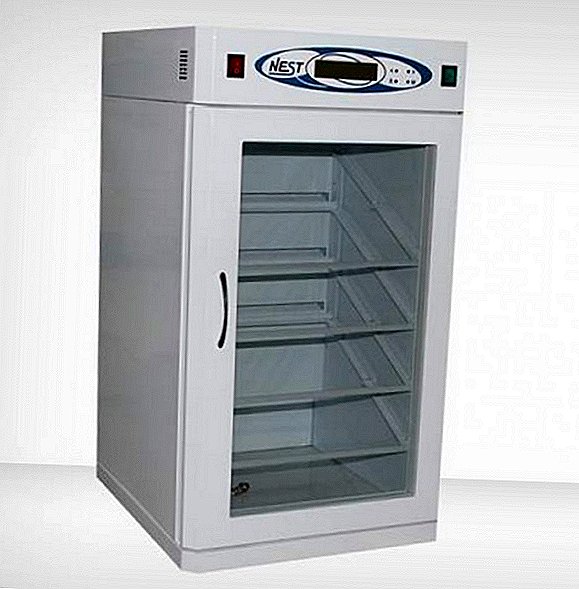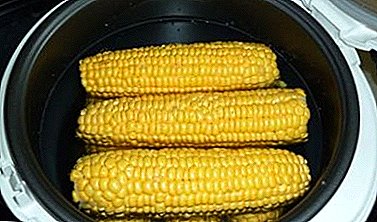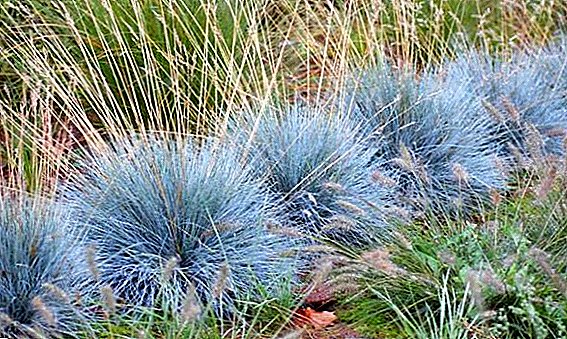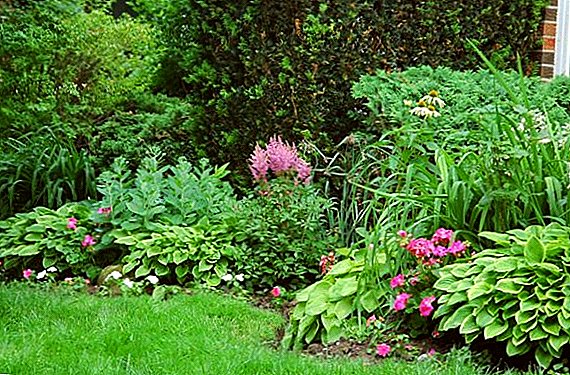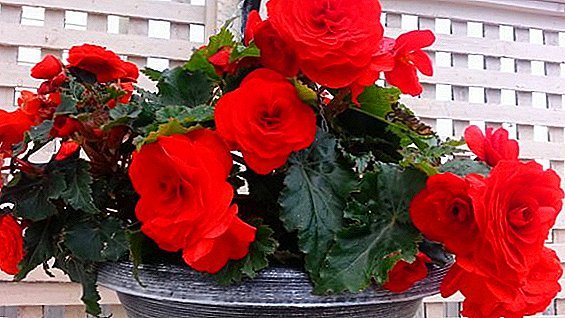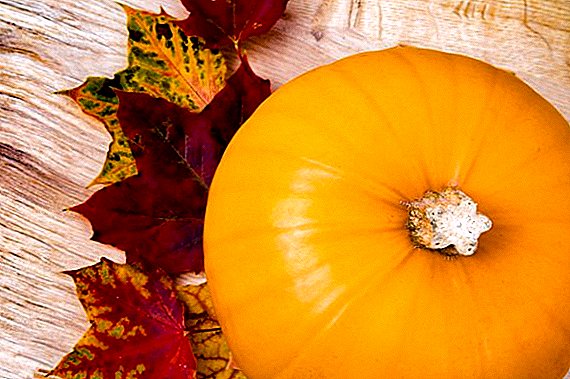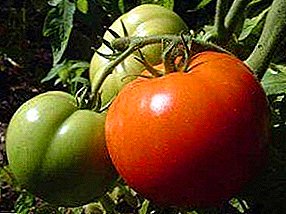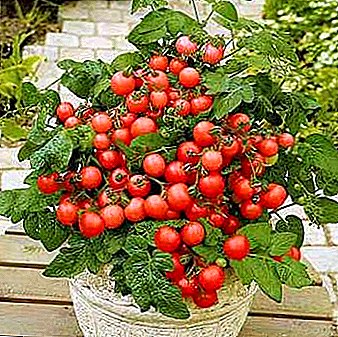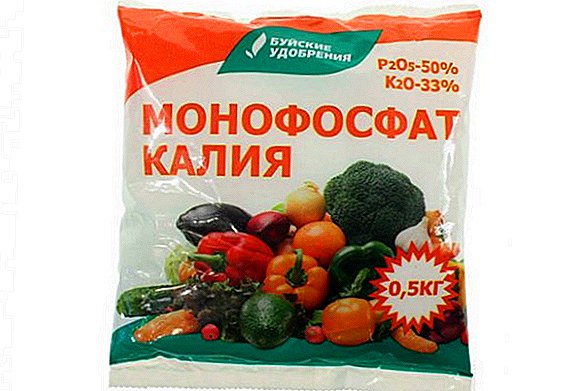 Of the various types of fertilizers, potassium monophosphate has gained wide popularity among gardeners and gardeners, since it is used both as potash and as phosphate fertilizer.
Of the various types of fertilizers, potassium monophosphate has gained wide popularity among gardeners and gardeners, since it is used both as potash and as phosphate fertilizer.
Description and composition
This substance belongs to complex potash-phosphate fertilizers. Externally, it looks like a white powder or granules. Its solubility in water at + 20 ° С is 22.6% by mass, and at + 90 ° С - 83.5%.
This means that this fertilizer is very soluble in water. The chemical formula of potassium monophosphate is KH2PO4. The content of potassium oxide (K2O) is 33%, and that of phosphorus oxide (P2O5) is 50%.
Important! In the composition of the fertilizer potassium monophosphate there are no such substances harmful to many plants: chlorine, heavy metals, sodium.
 While the mass fraction of potassium (K) and phosphorus (P) are respectively 28% and 23%. In terms of potassium content, this fertilizer is superior to potassium chloride and sulphate, as well as potassium nitrate. Phosphorus is overtaken by superphosphates.
While the mass fraction of potassium (K) and phosphorus (P) are respectively 28% and 23%. In terms of potassium content, this fertilizer is superior to potassium chloride and sulphate, as well as potassium nitrate. Phosphorus is overtaken by superphosphates.When potassium monophosphate is used
Its use increases the yield of both vegetable and fruit crops, has a positive effect on the quality of the fruits and vegetables themselves. This increases the resistance of plants to various diseases.
Fertilizing with potassium monophosphate is made according to the instructions for use and also contributes to the earlier, abundant flowering of various flower crops. Fertilizer is usually applied during spring processing of plantings, planting of seedlings and during the flowering period of plants, including decorative ones.
Important! Potassium monophosphate is not recommended to be mixed with drugs containing magnesium and calcium.

How to apply
This drug is used as foliar application or for application to the soil (open or protected), both independently and as part of mineral mixtures. It is usually used in the form of a solution, but can be applied to the soil as part of various dry mixtures.
A useful feature of the drug is its compatibility with almost any fertilizer, except those containing magnesium and calcium. The mixture with nitrogenous compounds has a beneficial effect on the development of the root system of plants.
Seedling
A solution of the drug for irrigating the soil, in which the seedlings are growing (vegetable or flower), is prepared in a ratio of 10 g of potassium monophosphate to 10 liters of water.  The same solution is used for the treatment of indoor plants, as well as flowers growing in the open air. When watering garden flowers consumed about 5 liters of solution per 1 square. m
The same solution is used for the treatment of indoor plants, as well as flowers growing in the open air. When watering garden flowers consumed about 5 liters of solution per 1 square. m
Vegetable
For irrigation of vegetables growing in open ground use a solution of potassium monophosphate in the ratio of 15-20 g of the drug per 10 liters of water. The application rate is 3-4 liters of solution per 1 square. m for young plantations (before budding) or 5-6 liters for more mature.
The same solution is used in the case of spraying plants. Treatment with the drug is made in the evening to avoid its rapid evaporation under the sun.
Fruit and berry
When processing fruit trees or berry bushes (by watering or spraying) use a more concentrated solution of the drug: 30 g of the substance is required for 10 liters of water.
For the bush consumption of the prepared solution is 7-10 liters per square meter. m of land, shaded at noon. For trees, consumption is higher - 15-20 liters per 1 square meter. m adjacent to the trunk surface of the earth. 
Advantages and disadvantages
Among the advantages of this fertilizer are the following:
- high content of K and P;
- good solubility;
- absorbed by all parts of the plant (roots, foliage, shoots);
- can be used for the prevention of fungal plant diseases;
- this drug is almost impossible to "overfeed" plants;
- does not affect soil acidity;
- compatible with other mineral fertilizers (except calcium and magnesium).
Did you know? Lack of phosphorus and potassium leads to a weak sugar content of the fruit.
This fertilizer also has some drawbacks, namely:
- quickly disintegrates in the soil, therefore, plant nutrition is usually produced by solutions;
- useful not only for cultivated plants, but also for weeds;
- incompatible with magnesium and calcium fertilizers, which limits its use for some plants (for example, grapes);
- the drug is hygroscopic, when wet quickly loses its properties;
- drug solutions are unstable, they can not be stored.

Did you know? The usefulness of potassium monophosphate for both cultivated plants and weeds can play a cruel joke. A case was recorded when, as a result of the application of this fertilizer, a giant bodyacon with a height of 4.5 m and a thick stem grew up in the garden. He had to cut down.
Precautionary measures
It is necessary to store the substance in a ventilated room, in which there is no access for children and animals. It can not be stored with food, medicine and animal feed. Wear rubber gloves when using.
If the drug gets on the skin or mucous membranes, they are thoroughly washed with running water. When ingested, the stomach is washed.
So, it can be argued that this drug is an effective fertilizer that contributes both to an increased yield of fruits, berries and vegetables, and prolonged flowering of garden flowers.  Numerous advantages make this fertilizer very attractive for any gardener or gardener.
Numerous advantages make this fertilizer very attractive for any gardener or gardener.


